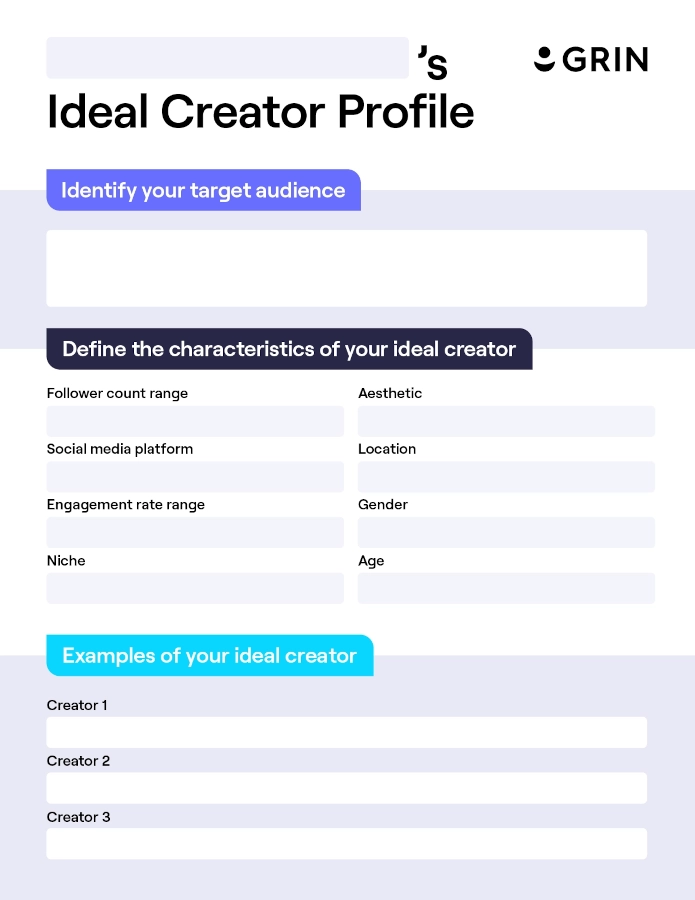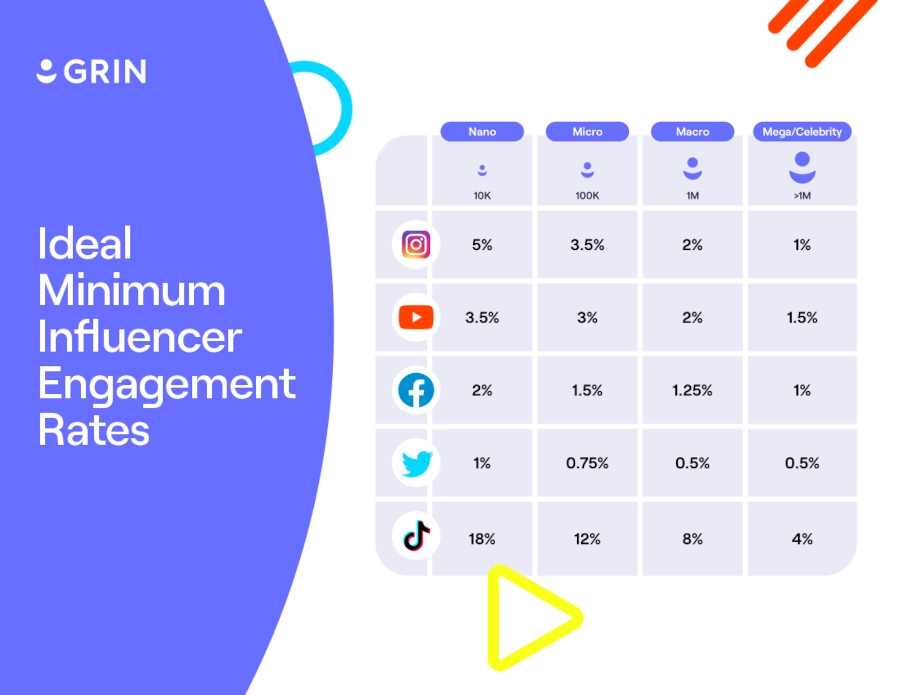Reading Time: 17 Minutes
Have you ever received a task with very little direction? Maybe it was sometime in grade school when a teacher asked you to write a 200-word poem about anything you wanted, or perhaps it was to find three influencers on any platform with any follower count to represent your brand.
The sheer number of possibilities probably left you feeling stuck and unsure how to move forward. You’re not alone. In fact, psychologists have noted the phenomenon of “overchoice,” in which people with too many options will have more difficulty making a choice than someone with limited options.
So how can you limit your options when researching ideal influencers for your brand? Developing an ideal creator profile is your best bet.
If you’re just starting out in influencer marketing, searching through millions of influencers can be overwhelming. Taking the time to develop an ideal creator profile will help narrow down the options and keep you on track.
And if you’re looking to scale your program, you might have an additional employee join your team. Sharing your brand’s ideal creator profile with them will help eliminate any confusion and allow them to get started much faster.
We’ve put together this printable guide for you to fill out as you follow along with this blog:

Download:
With so many variables to consider, every brand’s ideal creator will be different. Here are some of the top things to consider when mapping out your profile.
From an outsider’s perspective, it would seem obvious to go for the creators with the largest followings. After all, you want as many people as possible to hear about your products.
However, as an influencer marketing professional, you know bigger isn’t always better. While macro and mega influencers are good fits for some brands, they aren’t the right solution for others. They tend to have higher prices (which may be out of reach for small and medium businesses), and they typically have more general followings, meaning that you may be paying a lot to reach many people outside your target audience.
Nano and micro influencers can help brands reach more niche audiences, but they also generate less brand awareness due to their smaller followings.
Take some time to consider your budget, your audience, and your goals to determine a follower count range for your brand’s ideal partner.
It’s time to do some research. Take your ideal customer demographics, and see which social platforms they spend the most time on. For example, you probably wouldn’t try to reach baby boomers on Twitch or Gen Z on Facebook.
Statista is a great source for finding demographic information for all major social platforms.
Once you use demographic data to narrow your options, it’s time to go deeper. Are there communities for your industry on different platforms?
For example, BookTok, a book-loving group on TikTok, has spurred major growth in sales for bookstores and publishers. Search for relevant hashtags on different platforms to see if they have engaged and enthusiastic audiences.
Once you find the general following size and social platforms for your ideal creator profile, it’s time to think about engagement rate. It’s important not to skip ahead to this step because nano influencers have a much higher target engagement rate than macro influencers. For example, if your ideal creator is a micro influencer, they should have a rate of at least 23% on TikTok and 3.5% on YouTube.

Free Tool: GRIN’s Influencer Engagement Rate Calculator
While there are some general lifestyle influencers, most creators have a certain niche they talk about, and their audiences love them for their expertise in this area. Think about what niches would be an obvious fit for your brand. For example, fitness creators would be an ideal fit for athletic apparel or supplement companies.
Then, think of some less obvious ones. Dreamland Baby, a company selling weighted blankets and swaddles for babies and young children, reached out to nurses and sleep consultants in addition to more general mom influencers to make sure the right people could discover their products.
Our recommendation: Don’t limit yourself to one niche. Start with a few, test out partnerships, and see which work. You may be surprised by the results!
If your brand is all about the positive vibes, you may not want to partner with creators who are still in their emo “phase.” And if an influencer regularly posts images of their maximalist lifestyle but you offer minimalist products, you’re probably not the best fit.

Typically, brands want to match a creator’s aesthetic with their own, so think about some words you’d use to describe your vibes. Consider making a mood board too! Then keep this in mind when searching for future partners.
It’s essential to consider the creator’s location as well as their audience. If you only ship within the U.S., partnering with a Canadian influencer might not be the best plan. Take a moment and think about where you sell to. Then, get a little more granular. Are there regions that typically generate more sales than others? For example, you may ship throughout the U.S., but people in the North would be much more likely to purchase winter coats than people in the South.
Gender may or may not matter when it comes to identifying an ideal creator profile for your brand. Obviously, if you only sell supplements for women, you probably don’t want to partner with male influencers, but if you sell unisex clothing, it would make sense to recruit a diverse range of creators.
Think through who is buying your products, and use this data to inform your ideal creator profile.
Again, think of your target audience. Is there a general age at which people begin to use your product? If so, your ideal creator profile should reflect this.
In one of the most restrictive examples, you wouldn’t partner with creators under 21 if you were an alcohol brand. But this also applies more generally. If you’re selling business casual clothing, you’d probably want to partner with creators between 20 and 55.
Once you’ve nailed down the right type of creator for your influencer marketing program, how do you find them? Let’s dive into some easy techniques.
Keep your ideal creator profile next to you at all times, then open up one of the social media sites you’re going to use in your program. There are a few different ways to conduct searches on the platforms, but before we get into those, take some time to download the free GRIN Web Extension. This tool will give you instant access to metrics like engagement rate, follower count, and more, saving you time while helping you stay within your ideal creator profile.
People use hashtags to reach people in their niches, locations, and demographic communities. So think through your ideal creator profile and start typing in potential hashtags. Instagram, TikTok, and other platforms offer automated suggestions, so you can see what search terms are popular.
Here are some ideas for inspiration:
Once you find a creator or two you like, see what hashtags they frequently use. Plug those into the search bar to find similar creators.
If you’re searching for creators within a specific city, state, or region, you can use Instagram’s location tags to discover people in the area. One tip with this: Avoid looking at tags for major tourist attractions, as you’ll often get people from all over the world. Instead, use Google Maps to find coffee shops or other stores that locals would visit, and use those tags to discover your ideal creators.
There’s no clear way to search Instagram location tags on a desktop, but you can do it through the mobile app. All you have to do is type the name of the business or location into the search bar, hit enter, and scroll to “Places” on the top navigation bar. We suggest finding interesting creators on the app and then checking them out on a desktop, so you can access their metrics with the GRIN Web Extension.
Now that you’ve found a few creators you like, save yourself some trouble and let technology recommend similar people. Once you follow a creator on TikTok or Instagram, the platform will provide a section called “Suggested for You,” in which they display similar creators.
After you find some that look interesting, click on their profiles and see if they also fit within your ideal creator profile.
If you’re just getting started in influencer marketing, manual searching is the way to go. But if your program is more mature, a creator management platform can help you find, recruit, and work with influencers of all sorts.
Listen to This Episode: Hear how Gainful finds brand-aligned creators at scale on the GRIN Gets Real podcast.
After finding some great creators, you want to make sure their audience is full of real people and not a bunch of bots. Here are some things to keep in mind when analyzing a potential partner:
You should absolutely alter your ideal creator profile over time. Perhaps you’ve released new products, and your target audience has shifted. This would be a great time to either slightly change your existing profile or create a second for your brand.
Or maybe you aren’t seeing the results you were hoping for from your influencer marketing program. This could be a sign that your ideal creators aren’t connecting well with their audience.
Analyze your campaign data frequently, and don’t be afraid to make adjustments to keep your returns high.
Whether you’re searching on your own or as part of a team, writing down your guidelines for an ideal influencer will make discovering the perfect partner for your brand so much easier.
Learn more about influencer marketing: Influencer Marketing 101
Our team keeps a finger on the pulse, so you’re always working with the latest information.